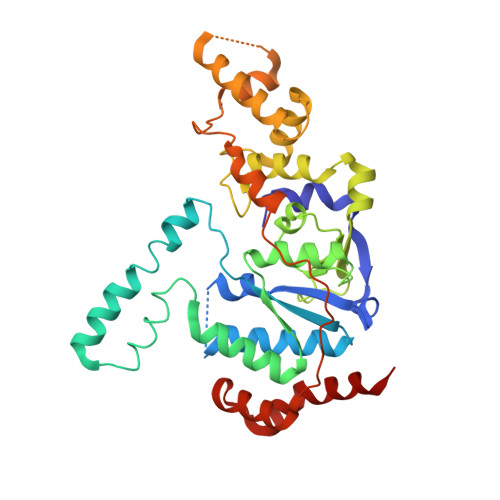Human XPG nuclease structure, assembly, and activities with insights for neurodegeneration and cancer from pathogenic mutations.
Tsutakawa, S.E., Sarker, A.H., Ng, C., Arvai, A.S., Shin, D.S., Shih, B., Jiang, S., Thwin, A.C., Tsai, M.S., Willcox, A., Her, M.Z., Trego, K.S., Raetz, A.G., Rosenberg, D., Bacolla, A., Hammel, M., Griffith, J.D., Cooper, P.K., Tainer, J.A.(2020) Proc Natl Acad Sci U S A 117: 14127-14138
- PubMed: 32522879
- DOI: https://doi.org/10.1073/pnas.1921311117
- Primary Citation of Related Structures:
6VBH - PubMed Abstract:
Xeroderma pigmentosum group G (XPG) protein is both a functional partner in multiple DNA damage responses (DDR) and a pathway coordinator and structure-specific endonuclease in nucleotide excision repair (NER). Different mutations in the XPG gene ERCC5 lead to either of two distinct human diseases: Cancer-prone xeroderma pigmentosum (XP-G) or the fatal neurodevelopmental disorder Cockayne syndrome (XP-G/CS). To address the enigmatic structural mechanism for these differing disease phenotypes and for XPG's role in multiple DDRs, here we determined the crystal structure of human XPG catalytic domain (XPGcat), revealing XPG-specific features for its activities and regulation. Furthermore, XPG DNA binding elements conserved with FEN1 superfamily members enable insights on DNA interactions. Notably, all but one of the known pathogenic point mutations map to XPGcat, and both XP-G and XP-G/CS mutations destabilize XPG and reduce its cellular protein levels. Mapping the distinct mutation classes provides structure-based predictions for disease phenotypes: Residues mutated in XP-G are positioned to reduce local stability and NER activity, whereas residues mutated in XP-G/CS have implied long-range structural defects that would likely disrupt stability of the whole protein, and thus interfere with its functional interactions. Combined data from crystallography, biochemistry, small angle X-ray scattering, and electron microscopy unveil an XPG homodimer that binds, unstacks, and sculpts duplex DNA at internal unpaired regions (bubbles) into strongly bent structures, and suggest how XPG complexes may bind both NER bubble junctions and replication forks. Collective results support XPG scaffolding and DNA sculpting functions in multiple DDR processes to maintain genome stability.
Organizational Affiliation:
Molecular Biophysics and Integrated Bioimaging, Lawrence Berkeley National Laboratory, Berkeley, CA 94720; setsutakawa@lbl.gov jdg@med.unc.edu PKCooper@lbl.gov jatainer@gmail.com.














